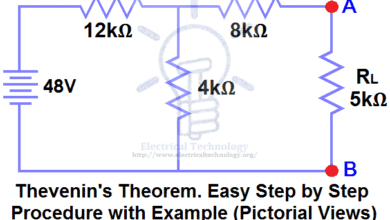Why are “High Voltage” Signs used when Only Current Kills?
Why are ‘High Voltage’ Warning Signs Used When It’s Only Current that can Cause Electrocution?
“High Voltage” warning signs are used to alert people to the presence of potentially dangerous electrical equipment or areas with high voltage electrical systems. While it’s true that it’s the electric current (measured in amperes or amps) that poses the greatest risk of causing injury or electrocution, the voltage (measured in volts) is the source of cause that drives the current in a circuit.
If there is no EMF (electromotive force) or voltage (potential difference between two points), there will be no current to flow in the circuit. It is the voltage that causes the current to flow in the circuit. That’s why scary voltage signs are used as warning in high voltage systems and equipment.
Related Posts:
- Which One Kills – Current or Voltage and Why? Amps vs Volts
- Which One is More Dangerous And Why – AC or DC?
Here are a few reasons why “High Voltage” warning signs are used instead of “High Current”.
Voltage Sign Indicates Potential Danger
High voltage means that there is a greater electrical potential difference between two points, and this can lead to more severe electrical arcs and sparks when a fault or accident occurs. These sparks can ignite fires or cause explosions in certain situations.
High Voltage Systems Need Special Precautions
High voltage electrical systems often involve higher levels of energy and more complex equipment, which can pose additional risks to those who work with or near them. People need to take extra precautions and use specialized personal protective equipment when dealing with high voltage systems.
High Voltage Systems are Not Accessible for Everyone
High voltage equipment and systems are typically not designed for untrained or unauthorized personnel to access. The warning signs serve as a reminder that entry is restricted or requires specific qualifications and permissions.
Voltage Indirectly Affect Current
While the current is the primary factor that determines the severity of an electrical shock, the voltage can indirectly affect the level of current that flows through a person. The resistance of the human body (which can vary depending on conditions) plays a role in determining the current. Higher voltage can overcome the body’s natural resistance more easily, potentially leading to higher currents and more severe injuries.
Draw Attention as Safety Precaution
“High Voltage” warning signs are used to draw attention to areas or equipment that involve higher voltage levels, which can indirectly affect the potential for electrical injury. They serve as a safety precaution to remind individuals to exercise caution, take appropriate safety measures, and ensure only qualified personnel access these areas to prevent accidents and injuries.
Related Posts:
- Why Can’t a 12V Car Battery Electrocute You?
- Why Don’t Birds and Squirrels Get Electrocuted on Power Lines?
The average resistance of a human body The voltage levels are harmful if greater than: The amount of electric current is enough for: The amount of electric current is fatal i.e.:
Related Posts:
- Which One is More Dangerous? 120V or 230V and Why?
- Which One is More Dangerous? 50Hz or 60Hz in 120V/230V?
- What Happens if a Battery is Connected to the AC Supply?
- What Happens When an AC Line Touches a DC Line?
- Is Lightning AC or DC ?
- What Happens if We Connect a Polar Capacitor the Wrong Way?
- Why Earth Pin is Thicker and Longer in a 3-Pin Plug?
- Why are Stones laid in an Electrical Substation?
- What happens if You Connect a 3-Φ Induction Motor to 1-Phase Supply?
- Protective Actions to Avoid & to Reduce Electric Hazardous
- Personal Protective Equipment (PPE) for Electrical Works
- Electrical Shock Hazards & Its Effects on Human Body
- What Do the 5P10 and 5P20 Mean in a Current Transformer?
- Why is the Grounding Wire Bare and Not Insulated?








